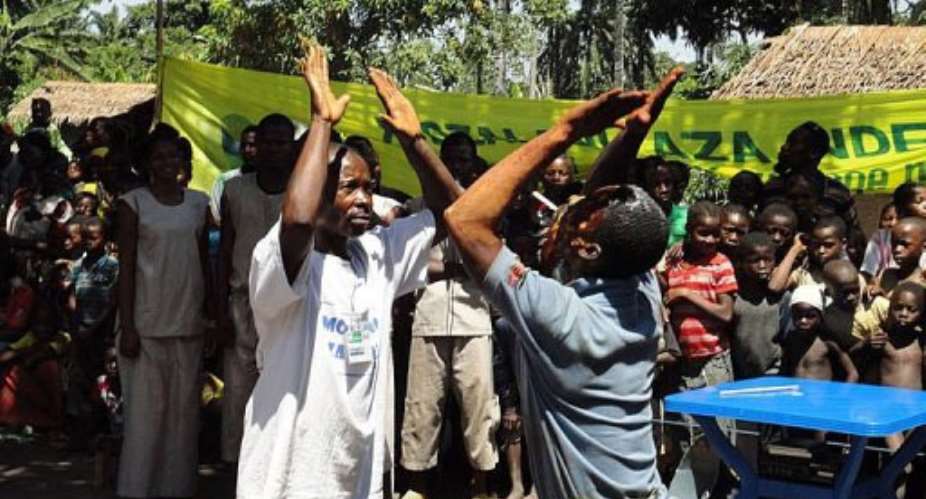MUNZAYA, DR Congo (AFP) - Torn apart in 2009 by inter-community bloodshed, the small village of Munzaya in the heart of the Congo rainforest is healing its wounds and rebuilding.
On July 4, 2009, Munzaya was attacked by neighbours from the village of Enyele. More than 300 houses were torched, trees felled, water wells destroyed. About a dozen people were killed.
The conflict, over the sharing of water, was the root of later attacks on a regional scale killing at least 270 people, according to authorities, and pushing 200,000 residents to flee their homes.
Today, Munzaya no longer shows the scars of the conflict.
Instead, three-room houses made of bamboo and straw have slowly risen, financed by the International Committee of the Red Cross.
The goal "is to build 227 houses for families who have returned to Munzaya for good," said the ICRC's Desire Mangela while attending a reconciliation ceremony between the two communities in May.
"We've already built 137 using local materials," she said.
Three-quarters of Munzaya's population have come home, according to local authorities.
"But famine and poverty remain," said Cesar Malungu, a 40-year-old fisherman and father of 13. "We're short of everything."
Buried in the dense rainforest of northwest Democratic Republic of Congo -- without running water or electricity and accessible only by narrow paths -- Munzaya covers one square kilometre (0.39 square miles) and has 3,000 residents.
The only outside communication is a shortwave radio, powered by solar panels.
"For provisions like salt and soap, villagers have to go to weekly markets sometimes 40 kilometres away," said Theophile Lambangi, a civil society representative for the South Ubangi district, where the village is located.
The only primary school has reopened, but it lacks benches and blackboards.
"Before the clash with Enyele the school had 445 pupils," said principal Bernard Bozumbu, "but today we only have 287."
An infirmary -- a three-room shanty -- treats three patients. Cases of measles, dysentry, and malaria are routine, treated without medical supplies, save a thermometre.
Two kilometres away via muddy paths and a short trip by raft, eight ponds filled with fish are shared with Enyele villagers.
"The Enyele began their insurrection here, but that's just a bitter memory," said Edouardin Mputu, a fisherman. "We're reconciled and they live among us."
© 2011 AFP





 Prince Harry, Meghan end Nigeria tour with Lagos visit
Prince Harry, Meghan end Nigeria tour with Lagos visit
 Presby Boys, Legon beat Prempeh College in Sharks Quiz
Presby Boys, Legon beat Prempeh College in Sharks Quiz
 CETAG members disapprove government’s approach to implementing NLC’s Compulsory ...
CETAG members disapprove government’s approach to implementing NLC’s Compulsory ...
 Voter registration: NPP's Richard Ahiagbah denies claims of double registration
Voter registration: NPP's Richard Ahiagbah denies claims of double registration
 Senegal buys back library of poet-president Léopold Senghor from France
Senegal buys back library of poet-president Léopold Senghor from France
 Ghana will lobby AU for intercontinental initiative on reparations – Akufo-Addo
Ghana will lobby AU for intercontinental initiative on reparations – Akufo-Addo
 Energy Commission warned gov't in 2023 about looming dumsor, issued advisory
Energy Commission warned gov't in 2023 about looming dumsor, issued advisory
 Dollarise Ghana’s economy to curb cedi depreciation — Dr Kwakye tells gov't
Dollarise Ghana’s economy to curb cedi depreciation — Dr Kwakye tells gov't
 NPP doesn't have flagbearer with Albion engine — Ken Kuranchie
NPP doesn't have flagbearer with Albion engine — Ken Kuranchie
 Afari Gyan is the most pragmatic EC Chair Ghana has had, Jean Mensa has failed a...
Afari Gyan is the most pragmatic EC Chair Ghana has had, Jean Mensa has failed a...
